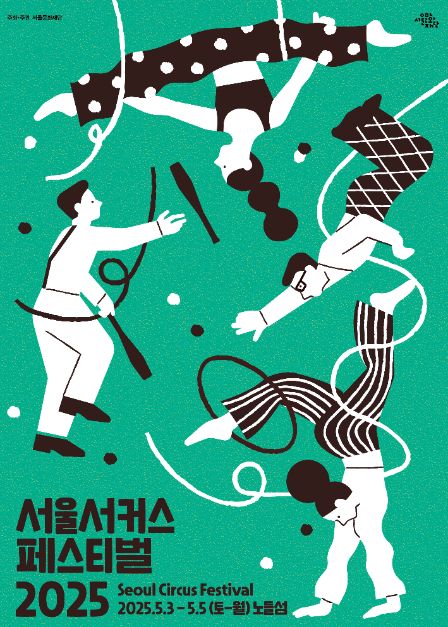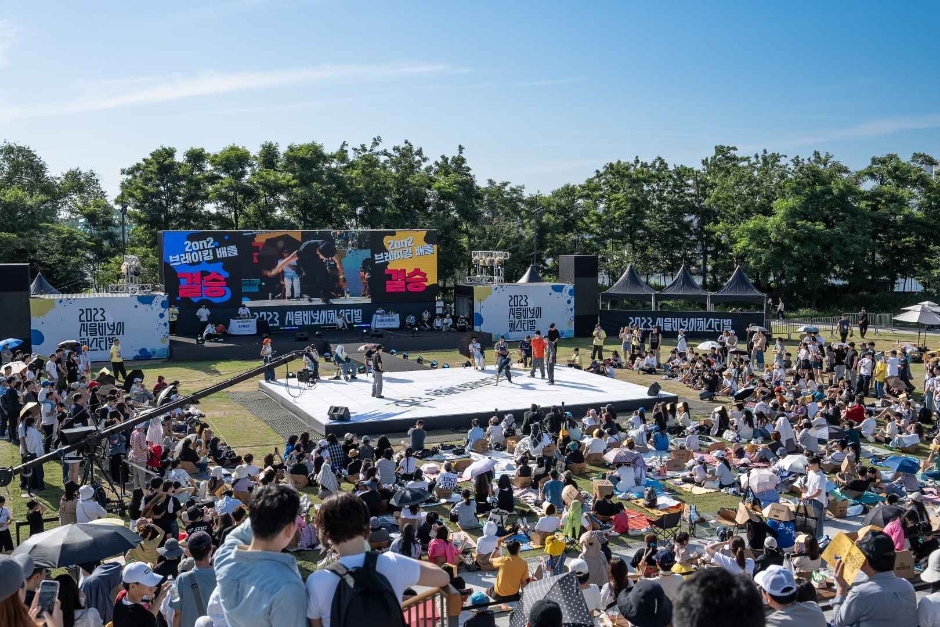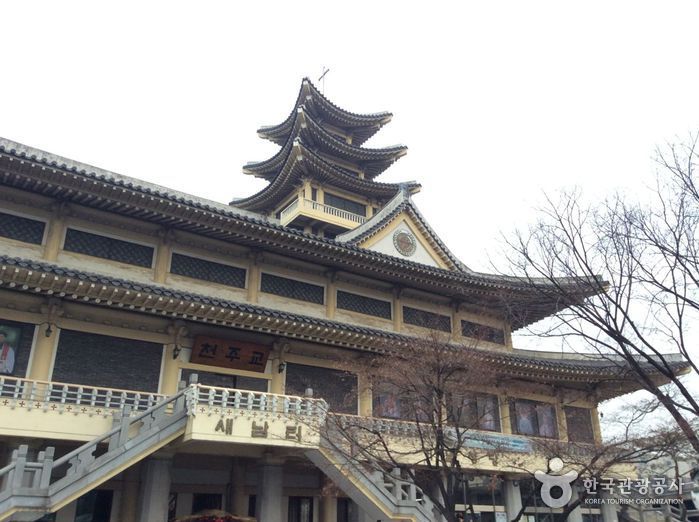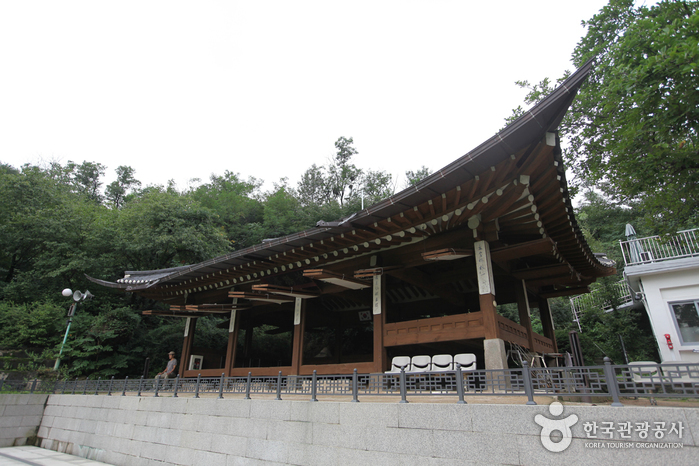Seoul Circus Festival (서울서커스페스티벌)
17.2Km 2025-04-23
445 Yangnyeong-ro, Yongsan-gu, Seoul
+82-2-758-2036
Seoul Circus Festival is Korea's only circus festival. During the fun-filled weekend, performers from all over the world come to showcase their talents and provide fun experiences for the whole family to enjoy. In addition to the circus acts, guests can enjoy movies, exhibitions, and a flea market.
Seoul B-dance Festival (서울비댄스페스티벌)
17.2Km 2024-05-22
445 Yangnyeong-ro, Yongsan-gu, Seoul
+82-2-758-2045
The Seoul B-dance Festival takes place on Nodeulseom Island in the Hangang River and helps kick off the summer season with break dancing and other modern b-boy styles of dance. Enjoy a range of street culture programs outside of dancing, including skateboarding and graffiti art.
Jihwaja (지화자)
17.2Km 2024-03-18
125 Jahamun-ro, Jongno-gu, Seoul
+82-2-2269-5834
Jihwaja is a traditional Korean restaurant operated by a successor of Joseon dynasty royal dishes. Their manchan course (full course) includes menus served at royal banquets such as gungjung manchan (royal course), Jineo-byul manchan (deluxe royal degustation course), and janggeum manchan (daejanggeum degustation course) courses. The janggeum course reconstructs dishes from the drama "Dae Jang Geum." For the Jeongchan course (Set menu), they offer so galbi sura (grilled beef ribs course), jeonbok cho sura (braised abalones in soy sauce course), so galbi jjim sura (braised beef short ribs course), and haemul sinseollo sura (seafood hot pot course). Additionally, they serve milk porridge, meat and vegetable skewers, mandu, royal hot pot, and grilled marinated beef.
Olens - Chung-Ang Univ. Branch [Tax Refund Shop] (오렌즈 중앙대)
17.2Km 2024-04-16
1F, 87-1, Heukseok-ro, Dongjak-gu, Seoul
-
Saenamteo Catholic Holy Place of the Martyrs (새남터기념성당)
17.3Km 2020-03-31
80-8, Ichon-ro, Yongsan-gu, Seoul
+82-2-716-1791
When taking the subway from Seoul Station to Yongsan Station, you will notice a tall and distinct hanok (traditional Korean architecture) building; this is Saenamteo Catholic Holy Place of the Martyrs. Construction of the building began in 1984, the year of the 200th anniversary of Catholicism in Korea, and was completed after three years.
Also called "Nodeul" and "Sanamgi," Saenamteo was used as a military training ground during the early Joseon period. It was also the place
where convicted felons and the Sayuksin (the six martyred ministers) were executed.
Many Catholics were executed here during the Sinyu Persecution of 1801, the Gihae Persecution of 1839, the Byeongo Persecution of 1846, and the Byeongin Persecution of 1866. Among those executed were 11 priests including the first Korean priest Kim Taegon (Andrew), the first Chinese priest that came to Korea Ju Mun Mo (Jacobus), the first French priest that came to Korea Bishop
Imbert and other Catholics including Hyeon Seok-mun. There is also an altar here where the remains of nine Catholic saints are enshrined.
Roem - Andong Branch [Tax Refund Shop] (로엠 안동점)
17.3Km 2024-06-27
30, Jungang-ro, Gwangju-si, Gyeonggi-do
-
Dongnimmun Yeongcheon Market (독립문영천시장)
17.3Km 2023-01-17
189-1, Tongil-ro, Seodaemun-gu, Seoul
Yeongcheon Market, which was formed in the 1960s near Dongnimmun Gate in Seodaemun-gu, is a marketplace with over 50 years of history and tradition, once famous as one of the largest rice cake wholesale markets in Seoul. It is set up near a residential district, which makes it one of the city's most notable street-style traditional markets that nearby residents frequently visit. The city of Seoul selected the area surrounding 38 Yeongcheonsijang-gil, Seodaemun-gu as the "Future Heritage of July" in 2021.
It is a large-scale traditional market that currently features around 198 stores, and it is well-known for its various foods and snacks such as tteokbokki and twisted donuts sold at about 40% of all shops.
Uniqlo - Namyangju Hwado Branch [Tax Refund Shop] (유니클로 남양주화도)
17.3Km 2024-06-26
1637, Gyeongchun-ro, Hwado-eup, Namyangju-si, Gyeonggi-do
-
Olive Young - Namyangju Hwado Branch [Tax Refund Shop] (올리브영 남양주화도점)
17.3Km 2024-06-27
1637, Gyeongchun-ro, Hwado-eup, Namyangju-si, Gyeonggi-do
-
Hwanghakjeong Pavilion (황학정)
17.3Km 2020-04-02
15-32, Sajik-ro 9-gil, Jongno-gu, Seoul
+82-2-738-5785
Hwanghakjeong Pavilion was built in 1898 by decree of King Gojong’s. It was originally set up close to the northern wall of Hoesangjeon in Gyeonghuigung Palace for archery practice. In 1922 when the Japanese colonial government sold buildings of Gyeonghuigung Palace to the public to build Gyeongseong Middle School in the location, the Hwanghakjeong Pavilion was bought and restored at the current location, which is an old site of Deunggwajeong Pavilion located to the North of Sajik Park.
It is relatively large for a pavilion, but the structure is plain and simple. There is a well behind the pavilion to the southwest. A rock behind the well has an engraved poem about eight beautiful scenes of Hwanghakjeong. Located to the right of the pavilion building (northeast of the building) is Hancheongak Pavilion, which has unique roof. To the west of the pavilion is Sauhoegwan Hall that was built with reinforced concrete.



![Olens - Chung-Ang Univ. Branch [Tax Refund Shop] (오렌즈 중앙대)](http://tong.visitkorea.or.kr/cms/resource/16/2880016_image2_1.jpg)

![Roem - Andong Branch [Tax Refund Shop] (로엠 안동점)](http://tong.visitkorea.or.kr/cms/resource/61/3314161_image2_1.jpg)
![Uniqlo - Namyangju Hwado Branch [Tax Refund Shop] (유니클로 남양주화도)](http://tong.visitkorea.or.kr/cms/resource/96/3313296_image2_1.jpg)

 English
English
 한국어
한국어 日本語
日本語 中文(简体)
中文(简体) Deutsch
Deutsch Français
Français Español
Español Русский
Русский